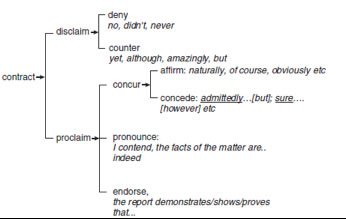Engagement
This section deals with writer’s “voice” and position in academic writing. In Martin’s work (2003) on appraisal system in English, he worked on the concept of engagement that “indicat[es] the speaker’s degree of commitment to the appraisal being expressed” (p. 142) Martin and White (2005) identified with Stubb’s (1996 in Martin & White, 2005) view that “whenever speakers (or writers) say anything, they encode their point of view towards it” (p.92).
The engagement system can be divided as monoglossia (single voice) and heteroglossia (multiple voices), where the former mostly appears in narrative genres, in which the authorial voice is dominant, and would not be discussed in this section. The heteroglossic nature of academic writing “[invoke] or allow for dialogistic alternatives” (Martin, 2000, p. 90-100), that is, allowing other voices to participate in the text, or as references to support and evidence.
Heteroglossia is further divided into two dimensions: the dialogic expansion and contraction. Put in simpler terms, semantic resources entertaining other voices, acknowledging sources, distancing from the authorial voice are dialogically expansive. Figure 3 is the choices of the dialogistic expansion of engagement system, with Table 5 illustrated with examples.
|
Categories |
Characteristics |
Examples |
| EXPANSION |
entertaining |
entertaining readers with possibilities with lexico-grammatical features such as modal verbs or adverbials |
- So we see that in the Hong Kong situation ESL speakers may not “pick up” meaningful cultural markers.
They would probably argue that if students were ever likely to encounter such an interpersonal dialogue in their lives outside the classroom.
While no doubt more manageable, the point is well made…
|
| acknowledging |
authorial voice standing with respect to propositions – with the use of “reporting” verbs such as say, report, state, believe and think |
- Nature and culture are highly appropriate concepts in the teaching of conversational English and are repeatedly cited by Carter himself (2001) and with McCarthy (2004) and Fung (2007).
Teachers applying a functional linguistic approach would argue that emotional insight or an authentic sounding conversation is of minor consequence to ESL learners.
|
| distancing |
distancing away from author’s position employing “scare quotes” or lexical items like claim |
- Indeed withholding exposure to culturally authentic dialogue is “disempowering and patronising” (Carter in Burns 2001).
Chomsky claimed to have shown that… (Martin & White, 2005, p.112)
|
Table 5. Engagement – Dialogic expansion with examples

Figure 3. Engagement – dialogic expansion (Martin & White, 2005, p. 117)
Dialogic contraction is narrowing down of the space for certain dialogic alternative through DISCLAIM (denial and countering) and PROCLAIM (limitation). DISCLAIM is further divided into DENY (negation) and COUNTER (concession), while PROCLAIM has three subcategories: CONCUR (alignment), PRONOUNCE (emphasis of authorial intervention) and ENDORSEMENT (sourcing warrantable external sources), as exemplified in Table 6 and Figure 4.
|
Categories |
Characteristics |
Examples |
| DISCLAIM |
DENY |
introduction of the alternative positive position into the dialogue to reject it, and disalignment with some third party through negation with lexical items such as no, never, do not. |
- 1. The point is well made that it does not provide students the opportunity to extend their spoken repertoire…
2. In many parts of Hong Kong the L2 environment in the wider society simply does not exist.
|
| COUNTER |
invoking of the contrary position that the expected proposition does not exist through adverbial/adjuncts like although, but, however, etc. |
1. Although the term “feel” is given only quasi-linguistic status it underlines a range of cultural sensitivities such as tone…
2. However, when the dialogue was recreated by the students…
3. But is it reasonable to suggest that by inserting appropriate DMs into the passage… |
| PROCLAIM |
CONCUR |
alignment with the dialogic partner to show the agreement or sharing of the same knowledge with the use of locutions like naturally, of course, definitely |
1. Their usefulness in spoken exchanges is certainly advantageous to the ESL speaker.
2. However, when the dialogue was recreated by the students unfortunately much of the humour was negated by the unnatural chunking of the text. |
| PRONOUNCE |
authorial emphases or explicit authorial intervention or interpolation with the use of I contend…, as a matter of fact, intensifiers such as really, indeed |
1. Indeed withholding exposure to culturally authentic dialogue is “disempowering and patronising” (Carter in Burns 2001).
2. I must assert that an awareness of the basic nature and types of discourse markers…
3. My own observations are that students struggle not to achieve meaningful conversation |
| ENDORSEMENT |
sourcing, with authorial subjectivity, of external sources as correct, valid, undeniable or maximally warrantable (cf. expand: acknowledging), construing the proposition with locutions such as prove, show, demonstrate, etc. |
1. Burns (2001) points out that students sense of security “evaporates” when confronted by authentic discourse exchanges.
2. Eggins (2000) makes the point that we do ourselves and the discourse community a great service |
Table 6. Engagement - Dialogic contraction with examples

Figure 4. Engagement – dialogic contraction (Martin & White, 2005, p. 134)
Close Window


